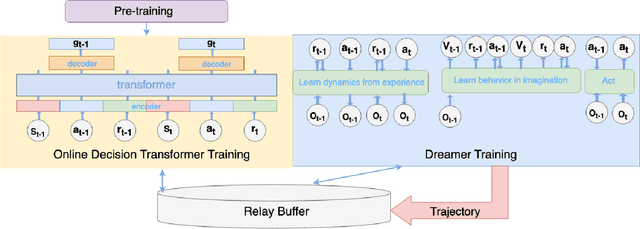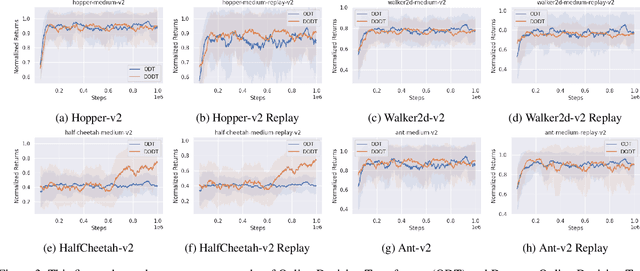Chenheng Xu
DODT: Enhanced Online Decision Transformer Learning through Dreamer's Actor-Critic Trajectory Forecasting
Oct 15, 2024



Abstract:Advancements in reinforcement learning have led to the development of sophisticated models capable of learning complex decision-making tasks. However, efficiently integrating world models with decision transformers remains a challenge. In this paper, we introduce a novel approach that combines the Dreamer algorithm's ability to generate anticipatory trajectories with the adaptive learning strengths of the Online Decision Transformer. Our methodology enables parallel training where Dreamer-produced trajectories enhance the contextual decision-making of the transformer, creating a bidirectional enhancement loop. We empirically demonstrate the efficacy of our approach on a suite of challenging benchmarks, achieving notable improvements in sample efficiency and reward maximization over existing methods. Our results indicate that the proposed integrated framework not only accelerates learning but also showcases robustness in diverse and dynamic scenarios, marking a significant step forward in model-based reinforcement learning.
CTSyn: A Foundational Model for Cross Tabular Data Generation
Jun 07, 2024Abstract:Generative Foundation Models (GFMs) have produced synthetic data with remarkable quality in modalities such as images and text. However, applying GFMs to tabular data poses significant challenges due to the inherent heterogeneity of table features. Existing cross-table learning frameworks are hindered by the absence of both a generative model backbone and a decoding mechanism for heterogeneous feature values. To overcome these limitations, we introduce the Cross-Table Synthesizer (CTSyn), a diffusion-based foundational model tailored for tabular data generation. CTSyn introduces three major components: an aggregator that consolidates heterogeneous tables into a unified latent space; a conditional latent diffusion model for sampling from this space; and type-specific decoders that reconstruct values of varied data types from sampled latent vectors. Extensive testing on real-world datasets reveals that CTSyn not only significantly outperforms existing table synthesizers in utility and diversity, but also uniquely enhances performances of downstream machine learning beyond what is achievable with real data, thus establishing a new paradigm for synthetic data generation.
 Add to Chrome
Add to Chrome Add to Firefox
Add to Firefox Add to Edge
Add to Edge